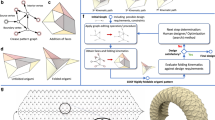Abstract
Paper is an underrated medium in multimedia technology. Rather than showing printed information only, it can also be used for creating real paper models from virtual objects by means of glue and scissors. This requires to compute a planar cut-out sheet from a 3D model. However, faces forming a model in 3D will often overlap once unfolded. While 3D space leaves much possibility for a non-intersecting topology of faces, they tend to intersect easily in the planar projection of the cut-out sheet. But overlaps are not the only problem. In some cases, neighboring faces enclose such a small angle that they are difficult to cut out and glue together. Unfolding a virtual model involves to decide which edges of a 3D model to cut first. A carefully chosen order can help to avoid the above mentioned problems in many cases. Finding the optimal order, however, is an NP-complete problem. In this paper, we develop and analyze a number of strategies that generate sheets which can be crafted easily and which yield high quality results.












Similar content being viewed by others
References
Abelson, H., di Sessa, H.: Turtle Geometry: The Computer as a Medium for Exploring Mathematics. The MIT Press, Cambridge (1980)
Diaz-Gutierrez, P., Bhushan, A., Gopi, M., Pajarola, R.: Constrained strip generation and management for efficient interactive 3d rendering. In: Computer Graphics International, pp. 115–121 (2005)
Dillencourt, M.: Finding hamiltonian cycles in delaunay triangulations in np-complete. In: Canadian conference on computational geometry (CCCG), pp. 223–229 (1992)
Evans, F., Skiena, S., Varshney, A.: Completing sequential triangulations is hard. Tr, State University of New York at Stony Brook (1996)
Evans, F., Skiena, S., Varshney, A.: Optimizing triangle strips for fast rendering. In: IEEE Visualization 96. San Francisco (1996)
Gopi, M., Eppstein, D.: Single-strip triangulation of manifolds with arbitrary topology. In: Computer Graphics Forum, pp. 371–379 (2004)
Julius, D., Kraevoy, V., Sheffer, A.: D-charts: Quasi-developable mesh segmentation. In: Computer Graphics Forum, Eurographics, Dublin, pp. 581–590 (2005)
Kolmanic, S., Guid, N.: A new approach in cad system for designing shoes. J. Comput. Inf. Technol. 4, 319–326 (2003)
Massarwi, F., Gotsman, C., Elber, G.: Papercraft models using generalized cylinders. In: Proceedings of the 15th Pacific conference on computer graphics and applications, pp. 148–157. IEEE Computer Society (2007)
Mitani, J., Suzuki, H.: Making papercraft toys from meshes using strip-based approxi- mate unfolding. In: Proceedings of ACM SIGGRAPH 2004, vol. 23, pp. 259–263 (2004)
Moritsugu, S.: Solving cubic equations by origami. In: Applications of computer algebra (ACA’2005), Nara city (2005)
Read, R.C., Tarjan, R.E.: Bounds on backtrack algorithms for listing cycles, paths, and spanning trees. Networks 5, 237–252 (1975)
Sells, E., Smith, Z., Bailard, S., Bowyer, A., Olliver, V.: RepRap: The Replicating Rapid Prototyper—maximizing customizability by breeding the means of production, pp. 568–580. World Scientific (2009)
Shafae, M., Pajarola, R.: Dstrips: dynamic triangle strips for real-time mesh simplification and rendering. In: Pacific Graphics, pp. 271–280 (2003)
Shatz, I., Tal, A., Leifman, G.: Paper craft models from meshes. Vis Comput Int J Comput Graph 22, 825–834 (2006)
Straub, R., Prautzsch, H.: Creating optimized cut-out sheets for paper models from meshes. In: Proceedings of the ninth SIAM conference on geometric design and computing. SIAM (2005). http://www.ibds.uni-karlsruhe.de/papers/cut-out-sheets.pdf
Xiang, X., Abd, J.S.B., Mitchell, M.H.: Fast and effective stripification of polygonal surface models, vol. 3, 71–78 (1999)
Yamauchi, H., Gumhold, S., Zayer, R., Seidel, H.: Mesh segmentation driven by gaussian curvature. Vis Comput 8(10), 659–668 (2005)
Author information
Authors and Affiliations
Corresponding author
Additional information
Communicated by P. Pala.
Rights and permissions
About this article
Cite this article
Haenselmann, T., Effelsberg, W. Optimal strategies for creating paper models from 3D objects. Multimedia Systems 18, 519–532 (2012). https://doi.org/10.1007/s00530-012-0273-1
Received:
Accepted:
Published:
Issue Date:
DOI: https://doi.org/10.1007/s00530-012-0273-1




